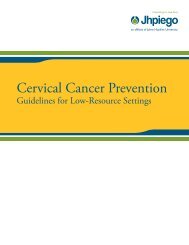Manual for Male Circumcision under Local Anaesthesia
Manual for Male Circumcision under Local Anaesthesia
Manual for Male Circumcision under Local Anaesthesia
Create successful ePaper yourself
Turn your PDF publications into a flip-book with our unique Google optimized e-Paper software.
<strong>Male</strong> circumcision <strong>under</strong> local anaesthesia<br />
Version 3.1 (Dec09)<br />
about what has happened and the plans to deal with the complication.<br />
Anxiety and fear of the unknown add to the distress caused by<br />
complications. These can be greatly reduced if the client is given clear<br />
explanations about what is happening.<br />
For example, a complaint of increasing penile pain and fever 4–5 days<br />
after surgery is indicative of wound infection. If there are signs of<br />
infection on examination, the client should be given antibiotics and the<br />
situation reviewed after 24–48 hours, depending on the severity of the<br />
complaint. In these circumstances, the client and his family should be<br />
told there is an infection, that antibiotics are needed, and when the<br />
situation will be reviewed.<br />
Organizing referrals<br />
A circumcision team working in a clinic setting should have a <strong>for</strong>mal<br />
arrangement with the nearest referral centre, so that there are no<br />
bureaucratic obstacles when referral is required. When strengthening<br />
or establishing national or local circumcision services, adequate<br />
funding <strong>for</strong> referrals should be included as part of the cost of the<br />
circumcision service.<br />
Many complications can be managed in the clinic setting, but<br />
occasionally emergency transfer may be needed. When there is a<br />
need <strong>for</strong> emergency transfer, the following general rules apply:<br />
• The client should be transferred by ambulance, lying flat.<br />
• The client and his family should be given a full explanation of what<br />
is happening and why.<br />
• A clear note should be sent to the referral centre with the client.<br />
• The client should be told not to eat and, depending on the length<br />
of the journey, not to drink, as a general anaesthetic may need to<br />
be given at the referral centre. Any accompanying family member<br />
should also be given this in<strong>for</strong>mation.<br />
Complications occurring during surgery<br />
• Excessive adhesions. If the client has phimosis, so that the<br />
<strong>for</strong>eskin cannot be retracted prior to surgery, there is uncertainty<br />
about what will be found once the dorsal slit has been made and<br />
the <strong>for</strong>eskin retracted. If there are excessive adhesions, it may be<br />
difficult to separate the <strong>for</strong>eskin from the glans. Depending on the<br />
experience of the circumcision team, it may be better to stop the<br />
procedure and refer the man to a hospital. In this situation, the<br />
dorsal slit will have to be repaired, using stitches to stop bleeding.<br />
It will not be possible to put on a dressing because the man will<br />
need to urinate. Nevertheless, the area should be kept as clean as<br />
possible. The wound should be covered with a gauze swab, which<br />
the man can keep in place by wearing tight <strong>under</strong>pants.<br />
Arrangements should be made <strong>for</strong> the man to attend the local<br />
Postoperative care and management of complications Chapter 7-5
















